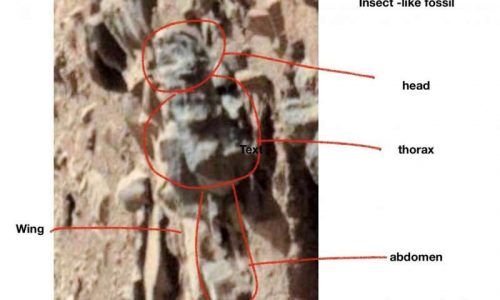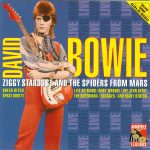You know what it is.
pareidolia
[ˌperēˈdōlēə]
NOUN
the perception of apparently significant patterns or recognizable images, especially faces, in random or accidental arrangements of shapes and lines.
“there could be a mysterious stone coffin on Mars, or, more likely, it’s just the latest example of pareidolia”
We’ve all seen shapes in clouds, or Jesus on a pita, but Mars seems to be a magnet for this phenomenon. This week, William Romoser, a well-known entomologist, presented a paper at the Entomology society meetings in St Louis titled “Does insect/arthropod biodiversity extend beyond earth?”
There is ample evidence to answer the question posed by the title in the affirmative. For several years, I have been engaged in study of the NASA-JPL photographs transmitted to Earth from the surface vehicles sent to explore Mars, Curiosity Rover in particular. These photos are available to the public via the internet. In this poster, I present and discuss numerous examples of insect/arthropod-like forms (fossil & living) found in Mars rover photos. Examples include insect-like forms displaying apparent diversity, clearly recognizable insect/arthropod anatomical features, and flight. Evidence of a fossil reptile-like (serpentine) form and reptile-like forms preying on insect-like forms is also presented. Each example is documented. These findings provide a compelling basis for further study and raise many important questions.
This is the new hobby for old cranks: poring over blurry photographs from exotic places, or odd-shaped rocks, and then leaping to the grand conclusion that it looks vaguely like X, therefore X lives in this place. Remember Mark McMenamin? He found fossil vertebrae, thought they were arranged in a pattern, and decided they were art created by an ancient kraken. Mars is a great font of pareidolia, with Schiaparelli thinking he saw canals, then Percival Lowell thinking likewise, and then there was the Face on Mars, which produced an explosion of very silly books and web pages in the 80s.
Now this guy is spotting all kinds of insects in still photos from the Mars rovers.
“Once a clear image of a given form was identified and described, it was useful in facilitating recognition of other less clear, but none-the-less valid, images of the same basic form,” Romoser said. “An exoskeleton and jointed appendages are sufficient to establish identification as an arthropod. Three body regions, a single pair of antennae, and six legs are traditionally sufficient to establish identification as ‘insect’ on Earth. These characteristics should likewise be valid to identify an organism on Mars as insect-like. On these bases, arthropodan, insect-like forms can be seen in the Mars rover photos.”
Distinct flight behavior was evident in many images, Romoser said. These creatures loosely resemble bumble bees or carpenter bees on Earth. Other images show these “bees” appearing to shelter or nest in caves. And others show a fossilized creature that resembles a snake.
I’ll let you be the judge. Do these look like Martian insects to you?
They look like fuzzily photographed rocks with circles and arrows and labels scribbled on them to me.
Besides, as everyone knows, there aren’t any beetles on Mars — they’re from Liverpool. Mars is supposed to have spiders.





How big are these magical insectivoid rocks supposed to be? I didn’t think Mars had an atmosphere capable of supporting metre long beetles, though I guess the spiders have to eat something.
“There is ample evidence to answer the question posed by the title in the affirmative.”
Anyone who writes a sentence like that, and not as a joke, is themselves, a joke.
FOCUS!!!
They have circles and arrows, but do they have a paragraph on the back of each one? Is PZ the blind justice?
So what are all these Martian insects living on then, given the notable lack of vegetation? (Don’t get me started on the ecology of Pitch Black…)
Still, maybe James Mickens will get his Gigantic Martian Insect Party after all… (Sorry, very obscure in-joke.)
The bottom pic looks like a cat laying on it’s back. Or maybe a squirrel, the red outline makes it look like a bushy tail.
No, he didn’t. Schiaparelli accurately reported seeing canali (channels) which was mis-translated as canals. It was the mis-translation that led Lowell to look for and imagine he’d found the canals.
Obviously El turned all martian life to stone as punishment for…whatever.And he is still messingv around:
“God to switch off gravity in Britain to save energy” http://www.newsbiscuit.com/2019/11/13/god-to-switch-off-gravity-to-save-energy/
Is everyone blind? These are clearly sandworms! I can even see a sandworm’s mouth in the first picture. So Mars has spice! It must also have water, although the water is stored in underground pools, which is why it looks like a desert on the surface. And spice means we can travel between the stars. We don’t need to terraform Mars or save the Earth from global scorching. We’re gonna have all the planets we need to live on!!!! Wheeeeeee …
So https://en.wikipedia.org/wiki/Quatermass_and_the_Pit_(film) was a documentary!
“…art created by an ancient kraken…”
Best turn of the crank ever! Beats out the lost continent of Mu and the Time Cube.
Insects on Mars, meh; bottom shelf stuff.
Enhance! Enhance!
Given that Mars has billions of small random features, the probability of finding a blurry image of a feature that looks like X for any familiar object X is 99.99…%.
pretty sure that second one is a penis
Its a scam. He makes you see insects so you don’t realise these are human body parts. Ignore the circles and arrows.
Hang on, I’ll get a pen and show you……
The mildly deranged penguin has conclusively identified those as the rind, crust, or inedible guts of Saturnian cheeses, which are known to vacation on Mars (warmer climate and more probes / rovers to surprise). She says Saturnian cheeses tend to shed their coverings on the warmer planets to avoid becoming fundue — which, she also claims, is what the Viking landers discovered.
I am horribly offended by the obscene images you have chosen to post here. I intend to complain to the censors.
I kind of doubt the ‘face’ on Mars inspired many web pages in the 1980s, given that by the end of 1989 “the web” consisted of a single memo saying that it would be a good idea.
Surely someone has noticed a picture of Jesus on one of these rocks?
I guess, if you squint at them for a bit, turn your head somewhat, maybe jiggle the images a bit, you could see them jumping, leaping, high up into the sky…